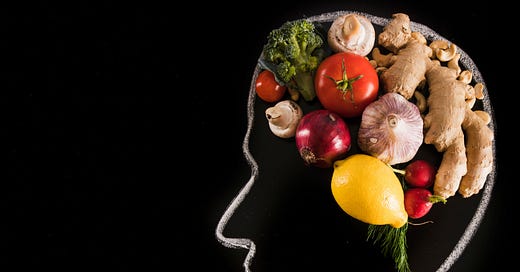A Chinese-Mediterranean Diet for Longevity and Memory?
How Asia may contribute to a better MIND
Everyone has lots on their minds nowadays. Here in the tiny PTFS corner of the world, we’ve been getting riled up about the Mediterranean Diet — suggesting that it’s a form of cultural imperialism — and how to chart personal paths to survive midlife and menopause. My original plan for this week was to segue us into tasty ways of cooking with tofu.
Alas, two subscribers, Mariel P. and
, separately emailed about the same blog post by Marion Nestle titled, “DRAFT The Ultimate Fusion Diet: Chinese-Mediterranean?”What did this ‘fusion’ diet deal with? A not-so-sexy-but-important topic: dementia, Alzheimer’s (ALZ), cognitive impairment. Oh boy.
The disease has been on my my mind since I edited Unforgettable (2017), a biography cookbook about culinary icon Paula Wolfert and her battle with ALZ. My mom, 89, regularly discusses dementia — her personal risks and how Mr. or Mrs. So-and-So have succumbed to it.
A friend shared that a family member, only in his 50s, was diagnosed with early on-set cognitive impairment. After a lady friend mentioned that hormone replacement therapy may lower risks of dementia, I looked up the 2023 study then asked my gynecologist. It’s still inconclusive, the doctor said.
So . . . chances are you’re simmering on this topic, too.
Firstly, do you know Marion Nestle? A molecular biologist, professor emeritus of New York University, and author of fifteen books, she is one of the foremost American authorities on public health and nutrition.
In 2024, we randomly met in Manhattan at the Saturday Union Square farmer’s market. She was grocery shopping and I was offering food samples and signing Ever-Green Vietnamese.
When she stopped by to ask about the plant-forward cookbook, I was astounded, fangirling as I introduced myself and my latest book baby. We chatted about the need to diversify the conversation about healthful eating.
It’s not just about the Mediterranean diet! Marion concurred Before we took this photo, she energetically said to a passerby, “Buy this book!” I blushed like an early Girl tomato. 🥰 🍅
She is a generous, wise woman. Ha ha, but seriously, thank you Marion (and to all of you who’ve joined her chorus).
How the Mediterrenean Diet applies to Asia
Back to Marion’s blog this week. The subject was the connection between food and cognitive impairment. The question was how the western-oriented MIND diet (Mediterranean-DASH intervention for neurodegenerative delay) can be applied to Asian populations.
Marion blog pointed to a study titled, “Association of adherence to the Chinese version of the MIND diet with reduced cognitive decline in older Chinese individuals: Analysis of the Chinese Longitudinal Healthy Longevity Survey.” It was recently published in The Journal of nutrition, health and aging. You can read and download a PDF of the whole shebang here.
Such a long, wonky title. Gimme the Cliffs Notes version, Andrea!
Okay. I took a read, invested elsewhere too, and these are the main takeaways.
What is the MIND?
In the realm of nutrition, MIND refers to a brain healthy diet that merges ideas from the Mediterranean diet with that of the DASH (Dietary Approaches to Stop Hypertension).
As outlined by the Harvard T. Chan School of Public Health, the MIND diet suggests the following:
Embrace:
3+ servings a day of whole grains
1+ servings a day of vegetables (other than leafy greens)
6+ servings a week of green leafy vegetables
5+ servings a week of nuts
4+ meals a week of beans
2+ servings a week of berries
2+ meals a week of poultry (not fried chicken!)
1+ meals a week of fish
Mainly olive oil if added fat is used
🍷 Wine: It’s up to the individual because reactions to alcohol vary quite a lot between people.
Avoid foods that are high in saturated and trans fats. If you must, it’s ok enjoy an occasional sweet, minimal red meat, some cheese, or a bit of butter!
What about an Asian MIND?
Researchers Wenjian Lin, Xiaoyu Zhou, and Xueyuan Liu noted that while the MIND offers a rubric designed to work for North Americans and “Oceanic” people (Australians?), how does it work for Asians?
Asians eat different foods and cook differently. Aside from culinary differences, there are cultural and economic differences too. (👋 Hello olive oil in Asia — you’re not easily found and expensive when you’re available.)
To investigate, the researchers used data from the decades-long “Chinese Longitudinal Healthy Longevity Survey”. That survey measures how diet, exercise, social, and environmental factors impacts health and lifespan. It’s one of the most extensive studies of its kind to include centenarians. (If you want to check it out, the survey info is at Duke University’s School of Medicine.)
Analyzing data collected from 6,411 people over age 65, the researchers applied a Chinese interpretation of the MIND diet (“cMIND”). They swapped in or added commonly eaten Chinese foods like rice, seaweed (algae), soybeans (tofu, soy milk, etc.), tea, garlic, and mushrooms. Instead of olive oil, they measured consumption of other plant-based cooking oils (mostly likely semi-refined rapeseed, peanut, and soybean oil).
Their main conclusions:
When people followed the cMIND, there was a markedly lower risk of cognitive impairment.
The cMIND is effective because of a combination of foods, not a silver bullet food.
However, a relatively high consumption of fresh fruit and nuts was connected with lower risks of cognitive impairment.
I once read that walnuts not only look like brains but are good for your brain too. That seemed silly at the time but there’s some truth behind it!
At one point, the Asian researchers listed the healthy brain benefits of certain cMIND food choices: [my lay language explainers in brackets hopefully helps to decipher the wonkiness]
Omega-3-rich fish has antioxidant and anti-inflammatory effects [fewer rogue reactions]
Mushrooms inhibit beta-amyloid formation [brain plaque]
Algae offers neuroprotection [keeps central nervous system strong]
Soy improves cognition through antioxidants [stabilize free radicals]
Garlic’s allicin reduces acetylcholine [neurotransmitter] degradation
Tea’s epigallocatechin gallate mitigates oxidative stress
Corn’s antioxidants provide neuroprotection
Edible plant oils contain essential fatty acids with neuroprotective effects, surpassing animal oils in unsaturated fatty acid content
Rich vitamin content of fruits and vegetables decelerates cognitive decline, and nutrients such as polyunsaturated fatty acids and polyphenols enhance cognitive function [yay! a healthier brain!]
Source: “Association of adherence to the Chinese version of the MIND diet with reduced cognitive decline in older Chinese individuals: Analysis of the Chinese Longitudinal Healthy Longevity Survey”
I may be biased but I read that as if the researchers were saying, “Hey, there’s something good here in the East too!”
The researchers mentioned nothing about traditional Chinese medicine (TCM) but surely, those notions favored certain ingredients over others in Chinese cuisine, which has in turn influenced neighboring Asian cuisines.
Bottom lines
Whether or not the researchers meant to push Asian healthful foodways into the West, there is a lot of cross-pollination to consider. Our grocery stores are better stocked now than ever. You can pick and choose what you want to put into your personal healthy eating program!
Public health diets can help by giving us general ideas. They’re usually not crafted by cooks so they often lack details such as: What is a single serving or meal? If there is a quantity specified, is it raw or cooked? For instance, what is meant by a "deck of card-size, 2 to 3-ounce portion of protein”? I wanna know if that’s raw or cooked meat if I’ve only allowed 1-ounce of wiggle room.
As a recipe developer, I know that raw meat loses about one third of its raw weight during cooking. A pound of leafy greens cooks down to a small mound. In a Viet meal you may consume lettuce like a hungry rabbit! Where does that fall into any prescriptive diet? Does it even matter?
Yesterday, while eating homemade pho that I’d prepared, my mom said, “When I’m alone, I eat very simply. I buy black beans from Sprouts, pressure cook them, then add ginger and a hint of sugar. I eat that batch of beans for days as chè đậu đen [a desserty snack], or as my soup course at a meal.”
You’re eating a sweet as a savory?
“Yes, I’m cooking for one so it needs to be ready made and last for a long time,” she said. “Sometimes I buy a bag of frozen corn from Trader Joe’s and blend up súp bắp [corn soup] to eat throughout a week. It’s easy but kind of sad.”
That’s not sad, I said. That’s smart plant-forward, high-fiber, brain-healthy eating. Mom responded with a smile.
She came from a plant-loaded cooking tradition, paid attention to western nutrition when raising us kids in Saigon (I was chubby!), then she switched to meatier meals after we got to America. Now, Mom is back to more vegetables. There’s always Trader Joe’s tofu in her fridge.
For Friday Lent dinner, I roasted a soy-sauce marinated yellowfin collar (it looks like a sting ray in the above photo) and we made tacos with the works. I’d also cooked up an eggplant, which my mom spied and said, “We’re eating that with fish sauce, yes?”
There’s room for many cultures in each person’s healthy diet and wholesome lifestyle. It doesn’t matter where you come from.
What are some of your healthy habits?
Next week, we’ll definitely be into the tofu scene. Also, on Thursday, 3/28, there’s a special Trader Joe’s Confidential Zoom for paid subscribers. There’s still time to ask your TJ question(s)! I’ll send Zoom link on Tuesday.
More soon, friends!
Andrea












Talk about fan-girling, seeing Marion Nestle and Andrea Nguyen together would about do me in! 😉
Great discussion, following right behind the last one on “later in Life.” I’ll find the Marion Nestle blog post and dive in there, as well
I had the pleasure of meeting Marion when I worked at a cooking school in NYC and she is remarkable! Thanks, Andrea!